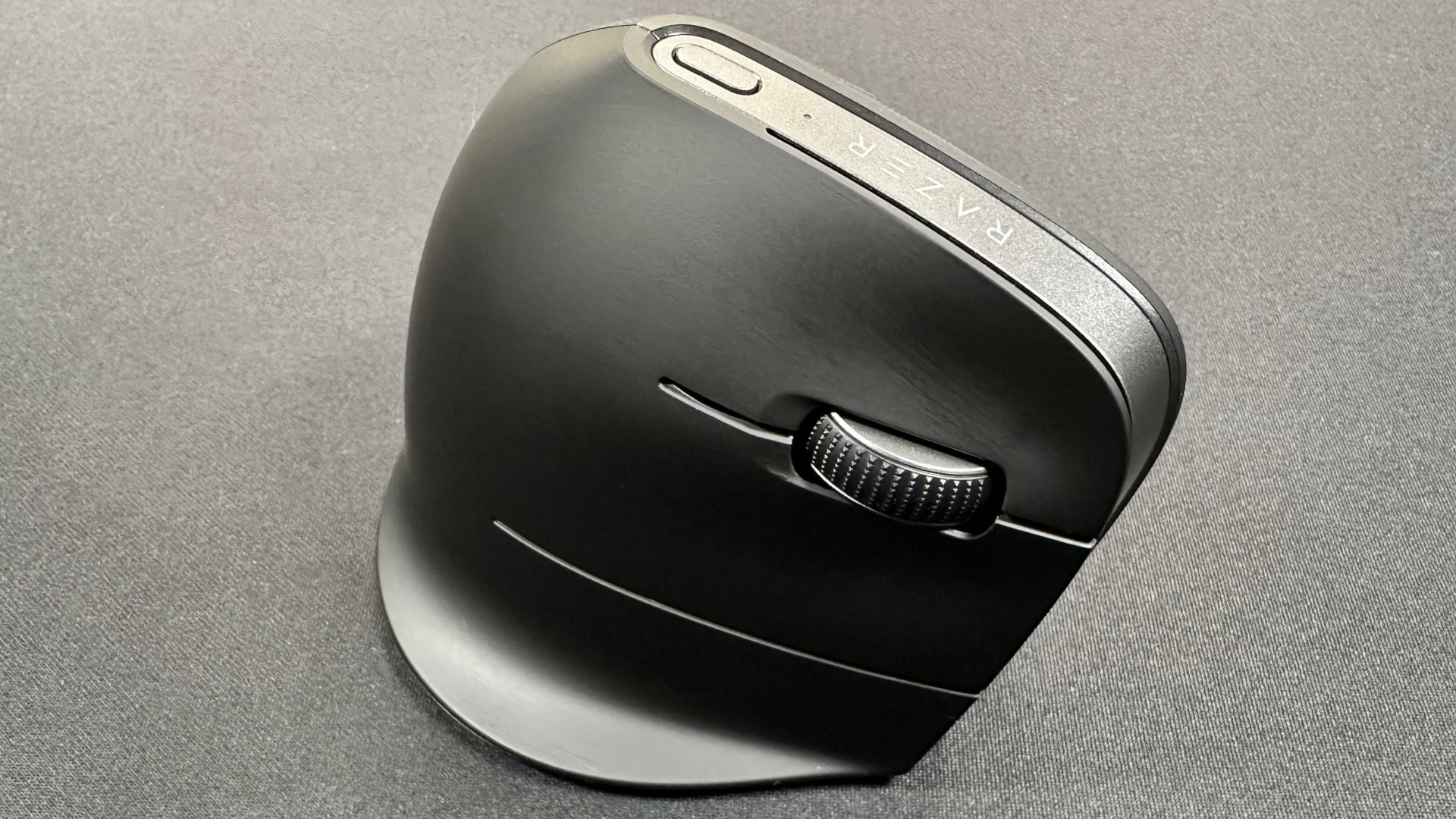AMD Ryzen 5, bringing competition to the mainstream
Fewer cores, a lower price, and firmware tuning turn Ryzen into a contender.

Last month saw the launch of AMD's new Ryzen 7 processors and the AM4 platform. I didn't score any of the CPUs at the time, in large part because giving a score on day one of a new microprocessor feels premature. And that goes double for the AM4 motherboards, as Jim and I discussed in our Ryzen state of the union address. A couple of more weeks brings more testing and maturity to AMD's platform, with most motherboards having received what might now be deemed 'final' firmware.
All of the preparatory groundwork laid by Ryzen 7 means the mainstream Ryzen 5 parts get to launch into a far more stable environment. Okay, maybe 'stable' is the wrong word—they get to launch with motherboards that are far less finnicky about memory and other peripherals. And with lower prices on the processors, the more budget minded are certainly going to think about the B350 chipset motherboards, which mostly cut down the number of USB ports and generally aren't intended for SLI or CrossFire setups.

One thing you should know before plunging into the Ryzen hardware scene is that spending a bit extra on memory could be worthwhile. I'll be looking at memory scaling more in a future article, but I did do some quick tests with DDR4-2133 (which no one really uses!) against DDR4-3200, and found the latter improved overall CPU performance by about four percent, but more importantly it improved gaming performance by seven percent. That's basically the equivalent of a 300MHz CPU overclock, thanks to better memory.
But there's a catch: not all Ryzen CPUs will run DDR4-3200, regardless of the timings. There's some variation between CPUs, and I have tested eight Ryzen processors now, several of which would only run the same kit of DDR4-3200 memory at DDR4-2933 speeds. And while you can try to push memory higher—I've heard of people hitting DDR4-3600 with the Asus ROG Crosshair VI Hero motherboard, via bus overclocking—that's going to require some luck in the silicon lottery. So don't bet the farm on an ultra expensive kit of DDR4-3200 CL14 RAM, but an extra $10-$20 to upgrade from vanilla DDR4-2400 to DDR4-3000 is worth considering.
Also pay attention to the type of RAM you're using. Officially, Ryzen processors only support DDR4-2667 speeds with two single-rank DIMMs. Use two dual-rank DIMMs and your maximum official RAM clock drops to DDR4-2400. With all four DIMM slots occupied, things get even worse: DDR4-2133 for single-rank DIMMs, and DDR4-1866 for dual-rank DIMMs. Unofficially you can try running higher clocks, but with four DIMMs you're likely going to get 2933 tops, and more likely 2667 or 2400.
If you want to know more about the Zen architecture at the heart of Ryzen, the earlier Ryzen 7 overview and architectural deep-dive cover the details. Today, I'm going to cut straight to the heart of the matter and dig into the specs and performance of the new Ryzen 5 processors. Here are the four new parts and their specs:

There are four Ryzen 5 processors, the Ryzen 5 1600X and Ryzen 5 1600 are 6-core/12-thread parts and the Ryzen 5 1500X and Ryzen 5 1400 are 4-core/8-thread parts. The X models come with higher clockspeeds and 'better XFR (Extended Frequency Range)—XFR lets the CPU can exceed the default maximum turbo clock with better cooling. As before, all of the Ryzen CPUs are multiplier unlocked, so you can try for higher clocks and in most cases I suspect all of these chips will reach 3.9-4.0GHz via overclocking (and sometimes more).
Keep up to date with the most important stories and the best deals, as picked by the PC Gamer team.
What's interesting is when we get into some of the additional details. It turns out that all of the current Ryzen 5 and Ryzen 7 chips use the same die, a two CCX module design with four CPU cores per CCX. The Ryzen 7 parts have all eight cores enabled, while the Ryzen 5 parts either have two cores (one per CCX) or four cores (two per CCX) disabled. The R5 1400 also has half the L3 cache disabled. That means each core on the 1600X and 1500X theoretically has more L3 cache available, but while the L3 cache is shared among all the cores, each CCX has half the L3 cache—and accessing data in the other CCX's L3 cache will be slower than if the data is in the local CCX's L3.
Long-term, I think AMD will come out with a native 4-core/8-thread Ryzen chip, where the best samples will be used as Ryzen 5 1400 (or maybe a future model), and it can also serve the Ryzen 3 market. This will be in AMD's best interest as manufacturing a large 192 mm^2 die with half the chip disabled isn't cost effective—but short-term, harvesting otherwise usable chips makes sense.
The big question is how Ryzen 5 performs, particularly in comparison to Intel's Core i5 models. The proof is in the eating of the pudding, and all the talk of CCX modules, cache sizes, Infinity Fabrics, and SMT doesn't matter one bit if the final result tastes like mud. So let's get to it.

Ryzen 5 performance
Before we get to the benchmarks, I need to set the stage properly. Last month when Ryzen 7 arrived, I mentioned the early teething platforms and the need to do some whacky things like disabling SMT to improve gaming performance. That felt like a stopgap solution, and for the Ryzen 5 performance I've skipped any of that silliness. If you're buying a 4C/8T or 6C/12T part, you're not going to want to reboot, enter the BIOS, enable/disable SMT, then restart—all in the name of slightly improved gaming performance.
There's a better reason to not bother with disabling SMT, and that's the fact that AMD's latest firmware updates appear to have improved the performance situation quite a bit. I retested one of the Ryzen 7 parts, the 1700, which I found to be the most compelling choice since it sells for just $330—and that includes a usable CPU cooler in the form of the Wraith Spire. I retested both stock and overclocked modes, and I'm in the process of retesting the 1700X and 1800X as well, but that will take a few more days.

The good news is that compared to my initial performance results, using the same Asus ROG Crosshair VI Hero motherboard updated to the 1002 BIOS (the fifth BIOS I've used on the board, if you're wondering), the change has been quite dramatic. At stock, the Ryzen 7 1700 is now running up to ten percent faster than before, which is a pretty crazy figure. Except it's not, really—the same thing happened with my initial Skylake i7-6700K motherboard, where a BIOS update improved performance by the same ten percent. File that away for reference next time a new platform comes out.
The problem with the new BIOS updates is that I haven't had the time to fully retest all the Ryzen 7 processors, so their entries on the charts are outdated. (I'll add them hopefully in the next day or two once I've had time to finish testing.) Regardless, most people looking at Ryzen 5 are likely thinking about a $200-$250 processor, maybe $330 at most—things like the 1800X or i7-6800K are a substantial price increase, catering to a different sort of user.
The second item to quickly cover is the test platform. AMD sent over an ASRock B350 Fatal1ty motherboard with the Ryzen 5 processors, and I used that in place of the Asus Crosshair VI Hero with its X370 chipset. AMD also sent a kit of GeIL DDR4-3200 memory, a Samsung 960 Evo 500GB SSD, and the Ryzen 5 1600X and 1500X—nope, no 1600 or 1400 samples for now. :sadface:
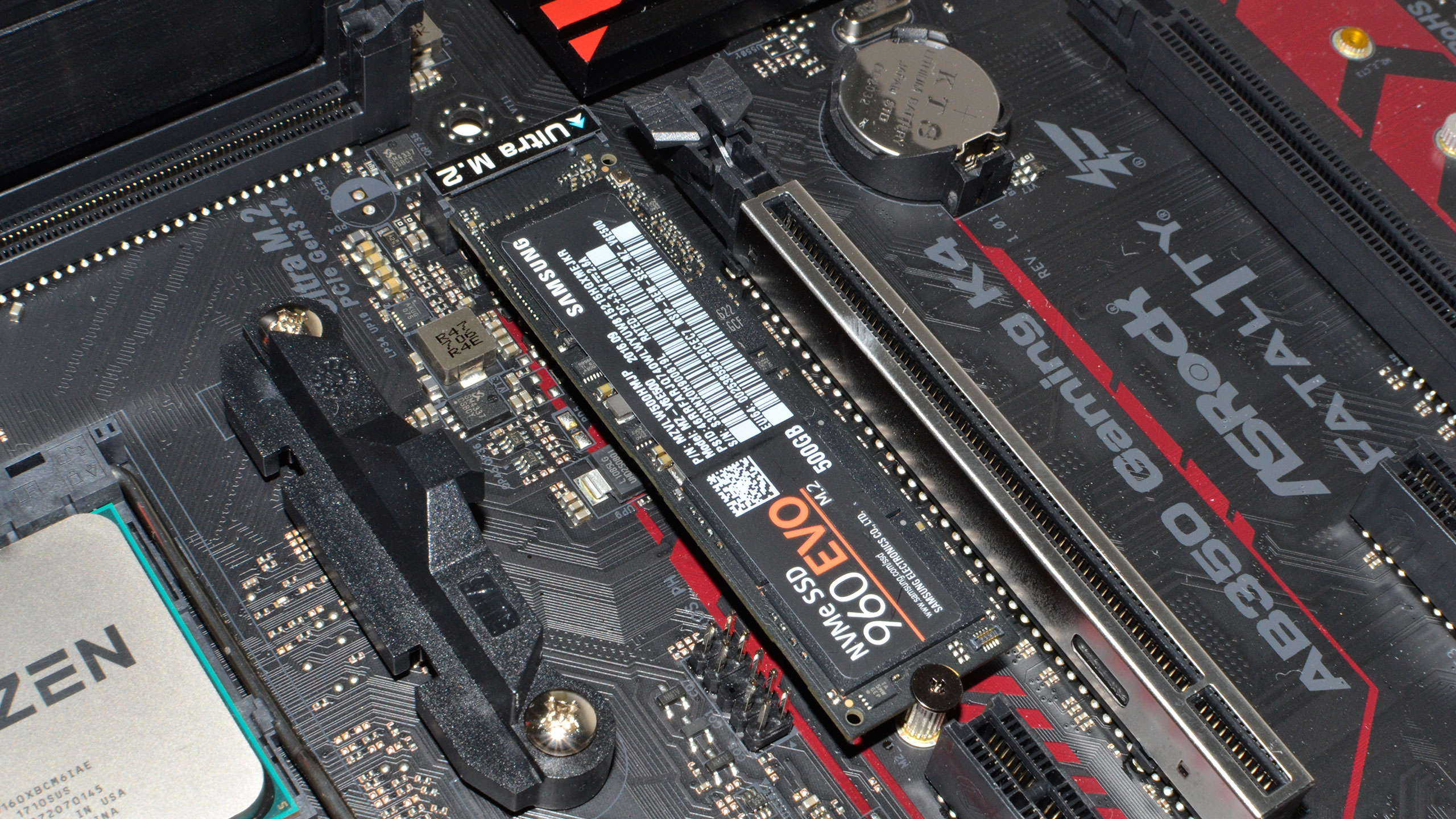
After the struggles I've had with some of the X370 boards, I was pleasantly surprised by the ASRock B350 board. It's not quite as fast as the Asus board (based on testing the Ryzen 7 1700), but it's not too far off, and it boots a bit faster as well thanks to a shorter POST sequence. I did discover that the second x16 slot wouldn't work with a graphics card, but that's not really the intended use anyway, so we'll just move along.
Going back to the silicon lottery, the 1600X worked fine using the XMP profile in the BIOS, booting without issues at DDR4-3200 with 16-16-16-39-1T timings. The 1500X was a different story, as I couldn't successfully POST at DDR4-3200. I eventually dropped to DDR4-2933 with the same 16-16-16-39-1T timings and it ran fine. In other words, the chance of getting a CPU that won't run at higher performance is very real. Same RAM, same motherboard, same components, but different CPU and the result was a lower memory multiplier. So if you buy DDR4-3200 memory, be prepared to potentially run at a slightly lower clock.
I've run my usual collection of ten tests, comprising six applications. You can see the individual results in the gallery below, and the overall performance looks very promising. The newcomer Ryzen 5 CPUs match up quite well against the i7-7700K/i7-6800K and i5-7600K for CPU performance, at least at stock clocks.

Swipe left/right for more.
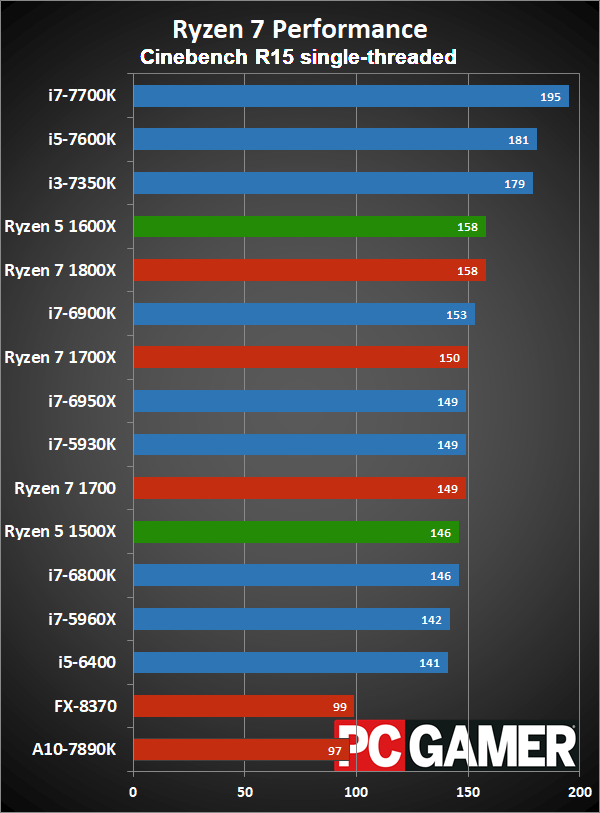
Swipe left/right for more.

Swipe left/right for more.

Swipe left/right for more.

Swipe left/right for more.
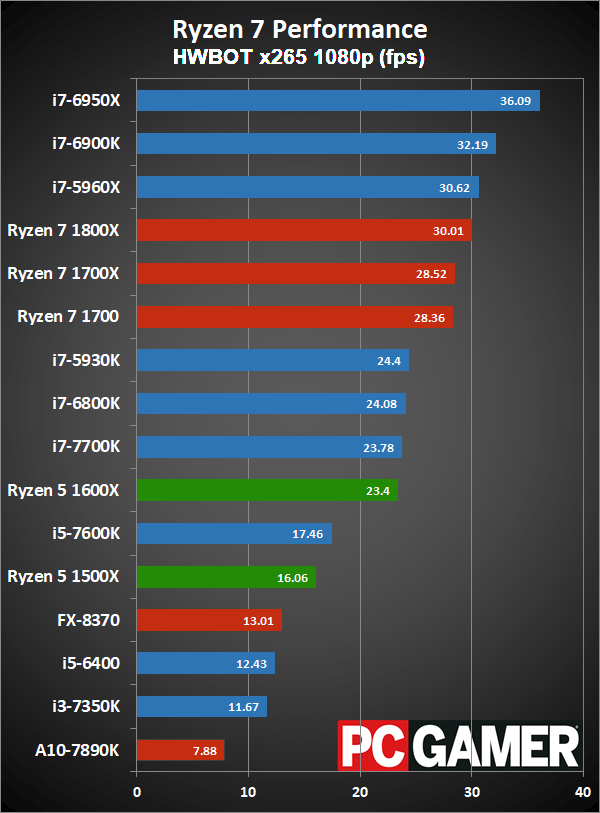
Swipe left/right for more.
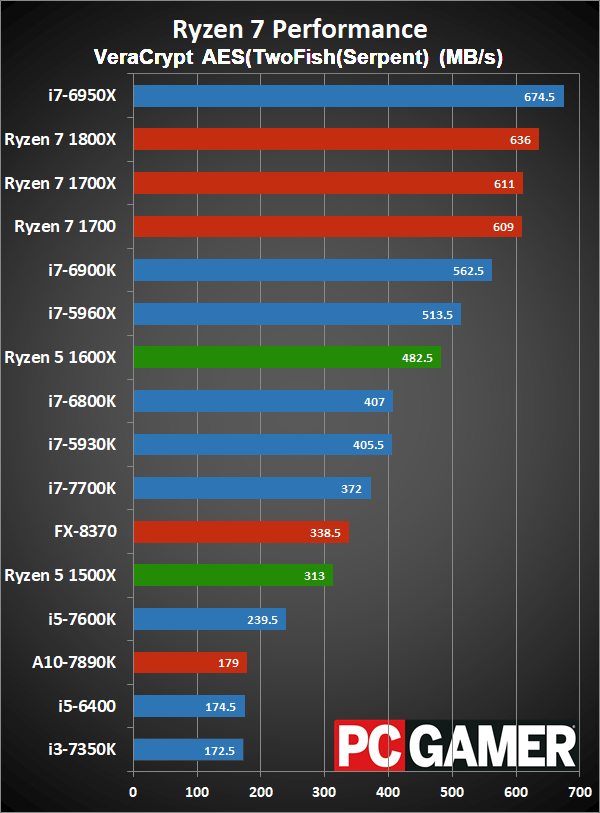
Swipe left/right for more.

Swipe left/right for more.

Swipe left/right for more.
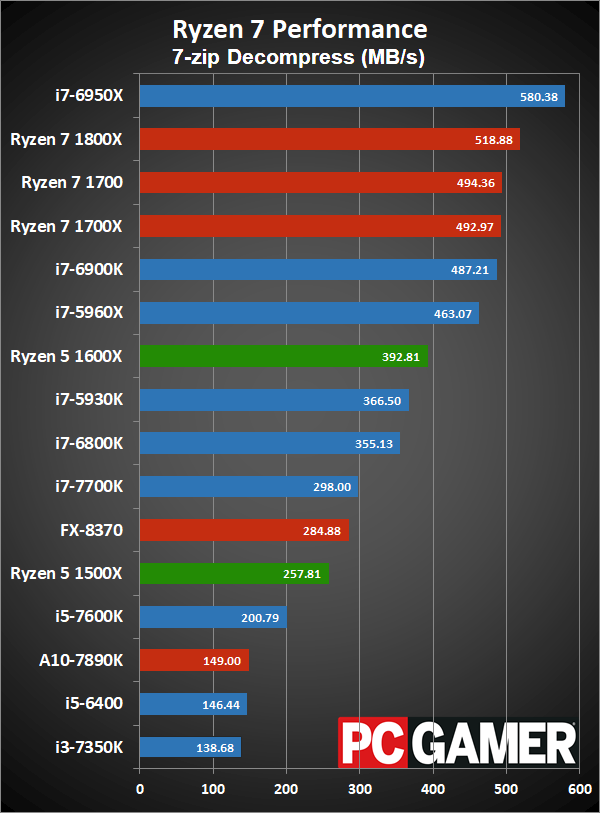
Swipe left/right for more.
Please note that the Ryzen 7 1700 and 1800X scores are outdated.
Given the core counts, the placing of the Ryzen 5 parts is about what you'd expect. The 6-core 1600X often beats Intel's 6-core parts, but it can't keep up with the 8-core offerings—never mind the 10-core 6950X that costs about seven times as much as the 1600X! Intel still holds a lead in y-cruncher, thanks to its superior AVX implementation, as well as the 7-zip compression test where the quad-channel memory controller comes into play.
Dropping down to the 1500X, despite having an equal number of cores/threads as the 7700K, it really ends up falling quite a bit behind that chip—thanks to Intel's substantially higher clockspeed. There are a few tests where it can beat the 7700K by a fair amount, and others where it loses by an equally large amount, with the overall average coming in just a hair behind the i5-7600K. That's not a bad place to be, considering the 1500X costs about $60 less than the 7600K.

Ryzen 5 gaming performance
Changes to the AM4 ecosystem by way of firmware updates aren't the only news for Ryzen. AMD has worked with two vendors to deploy optimized versions of their games, improving performance as a result. The two games are Ashes of the Singularity and Total War: Warhammer, both of which have been heavily promoted by AMD in the past. But even games that didn't receive a patch are showing better performance with the latest firmware updates. Here's what performance looks like for the current test suite of 14 games.
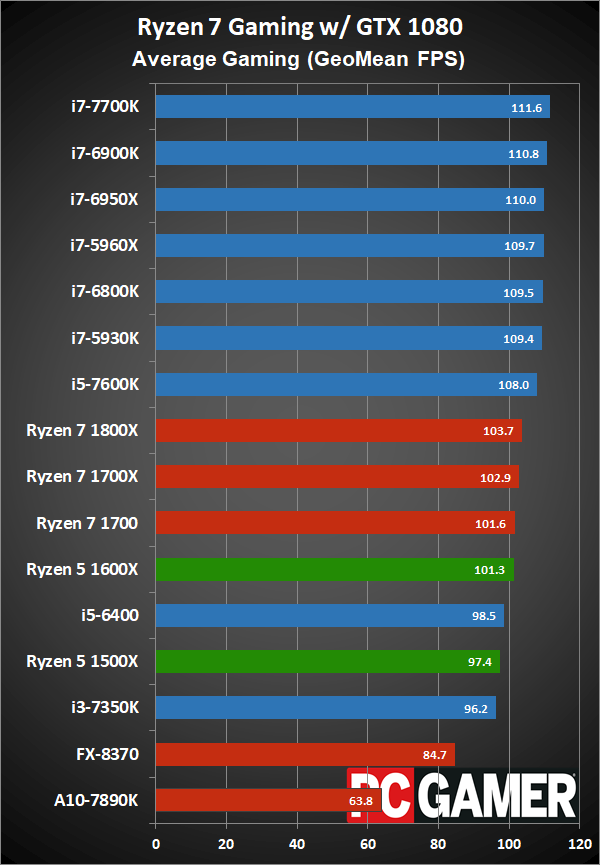
Swipe left/right for more.

Swipe left/right for more.

Swipe left/right for more.
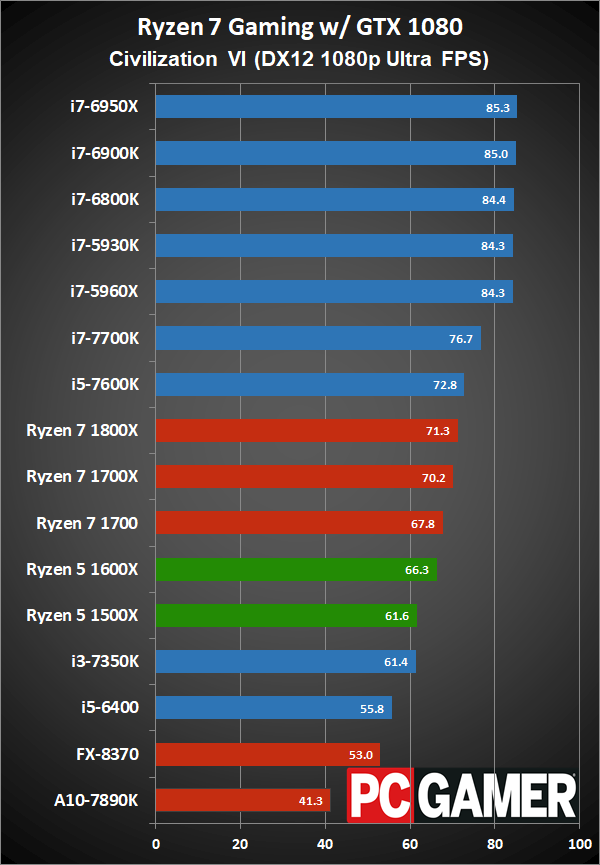
Swipe left/right for more.
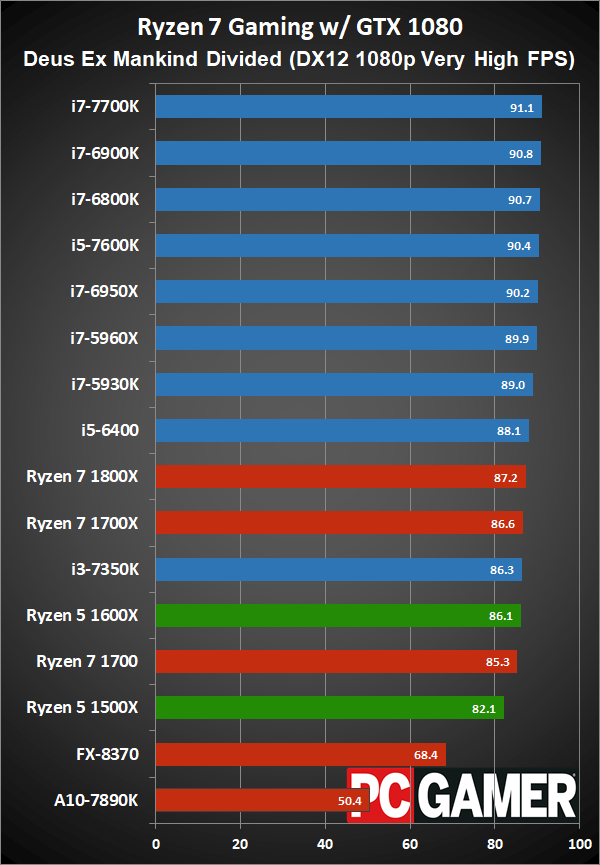
Swipe left/right for more.

Swipe left/right for more.

Swipe left/right for more.

Swipe left/right for more.
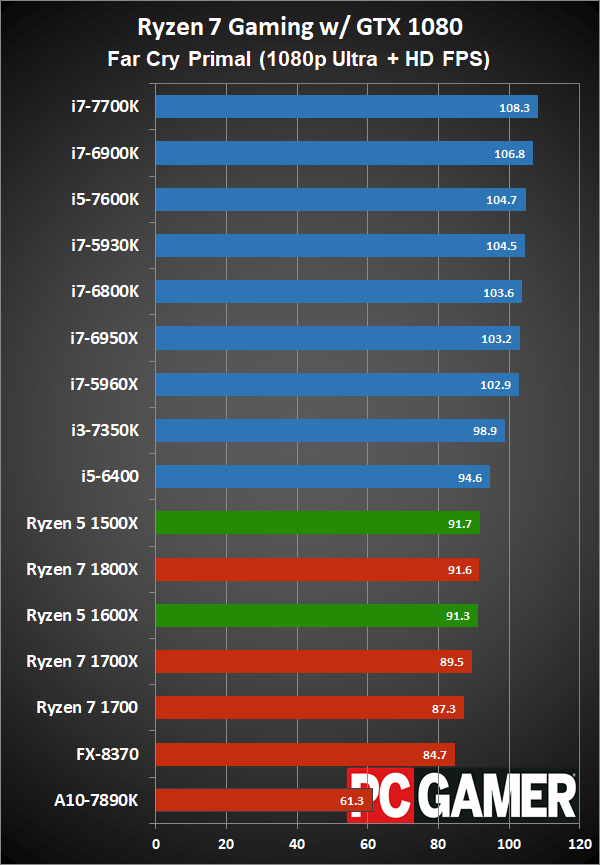
Swipe left/right for more.
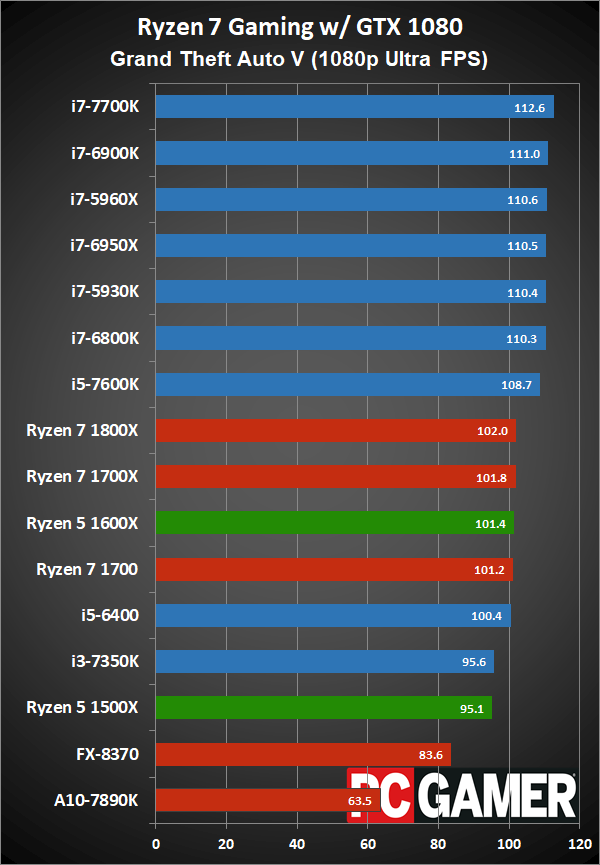
Swipe left/right for more.
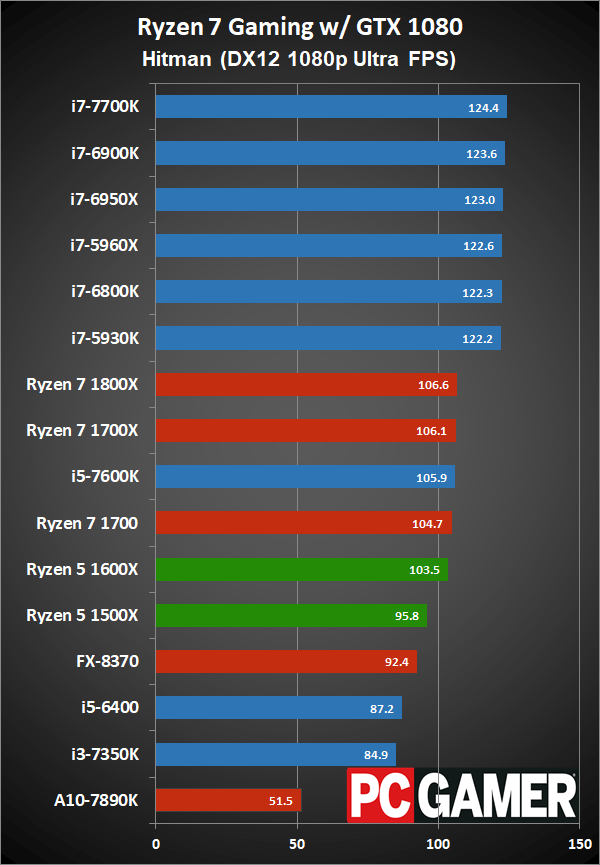
Swipe left/right for more.
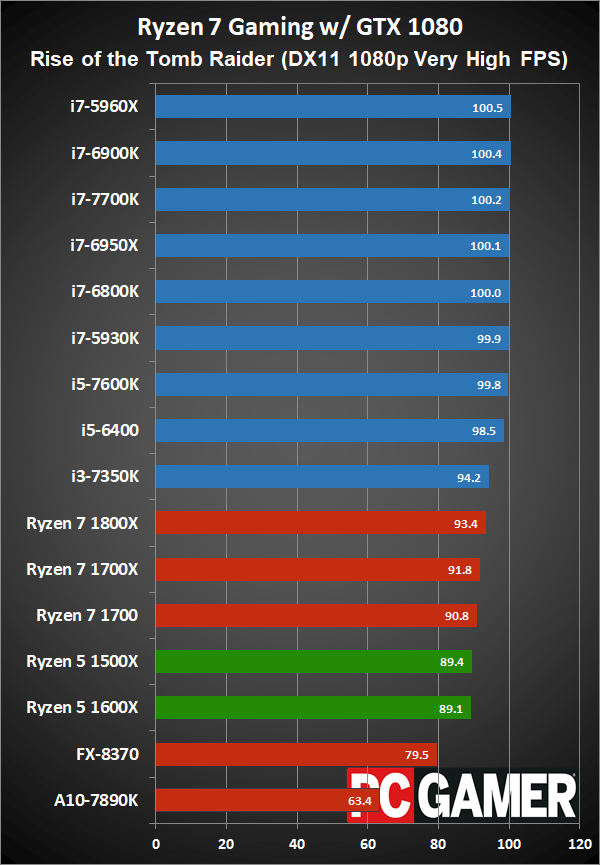
Swipe left/right for more.
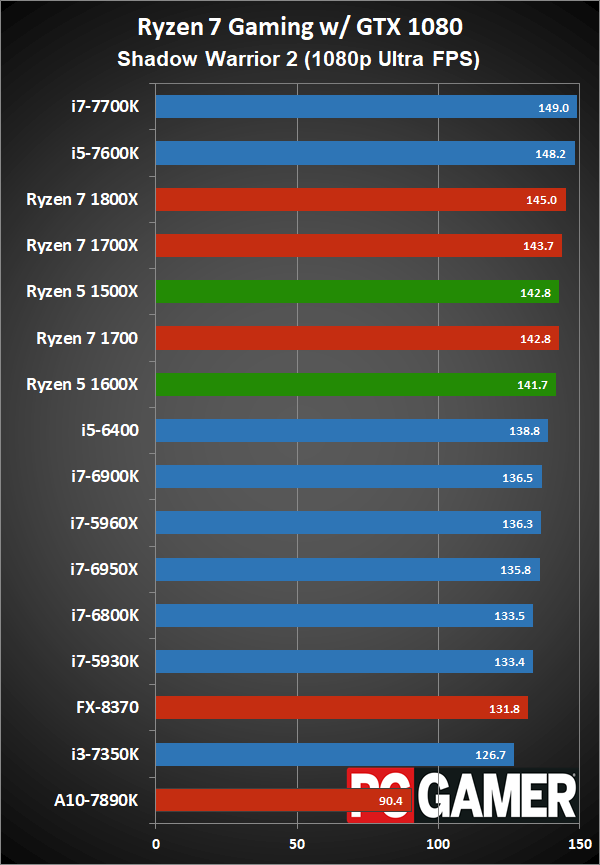
Swipe left/right for more.
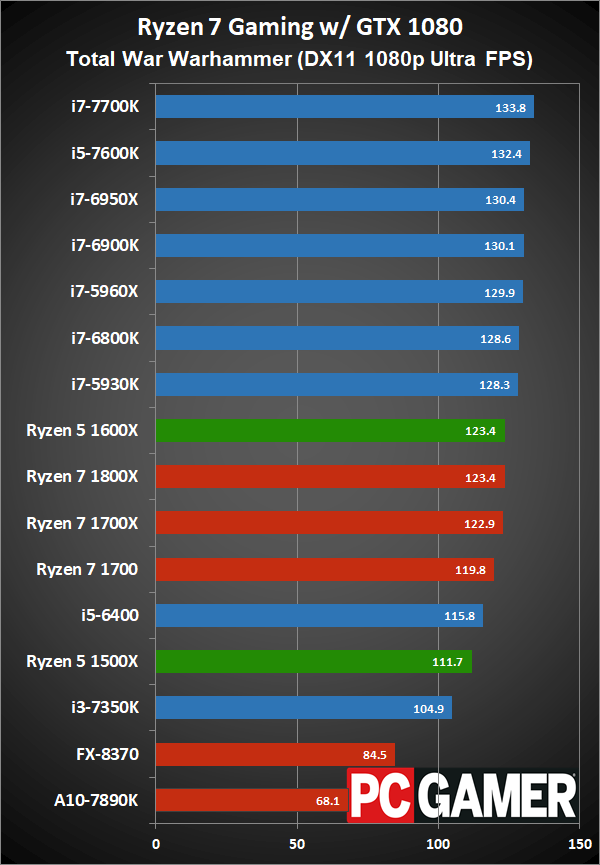
Swipe left/right for more.
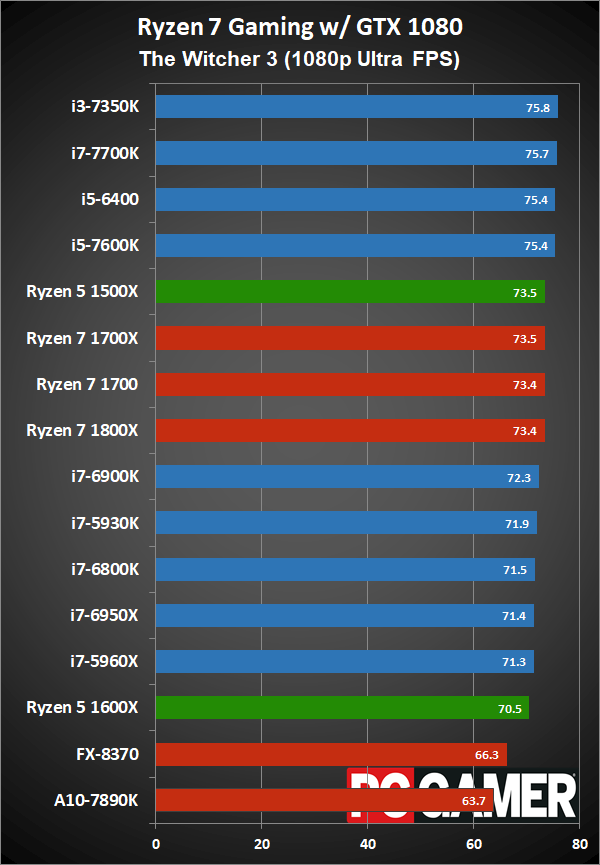
Swipe left/right for more.
Please note that only the Ryzen 5 and Ryzen 7 1700 scores are fully up-to-date.
As a gaming processor, Ryzen can hold its own, but it won't topple Intel—at least not without a lot more developers adopting multi-core aware engines. All of Intel's parts cluster together at the top of the overall rankings, with only the i3-7350K and i5-6400 falling off the pace. Ryzen does claim a few wins in the individual charts, mostly in cases where the game is GPU limited or has an fps cap. More importantly, if you're planning on using a less potent GPU, like a GTX 1070 or RX 480, a lot of the differences shown in these 1080p charts will start to disappear.
Probably the more important takeaway is that the 1600X is just as capable a gaming CPU as the more expensive Ryzen 7 offerings. The 1500X meanwhile lags a bit off the pace, and that's still the case when it's overclocked. It's not a huge deficit by any means, but I'm a bit surprised the drop from 6-core to 4-core even shows up. It rarely makes a difference on the Intel side of things, though admittedly that's comparing 6-core previous generation architectures against the 4-core Skylake/Kaby Lake chips. I'm inclined to recommend the 1600/1600X over the quad-core Ryzen 5 parts, just because that's where AMD's architecture delivers the greatest improvements over Intel's parts.

Ryzen 5 overclocking
All Ryzen parts are multiplier unlocked, so there's an opportunity to buy a less expensive CPU and overclock it to 4.0GHz—or 3.9GHz, which is what happened with the 1500X. So far only the 1800X and 1600X have managed to run through my full test suite at 4.0GHz, and I couldn't get either one to pass the suite at 4050MHz. The same goes for the 1700, 1700X, and 1500X, which all did 3900MHz but not 3950MHz without crashing on at least one or two tests. Liquid cooling didn't help much, though it dropped temperatures quite a bit.
In other words, overclocking remains a bit of a disappointment. I've been spoiled by Intel's 4.7GHz (Skylake) to 5.0GHz (Kaby Lake) overclocks, which are particularly nice on chips like the K-series Core i5 parts, netting about a 20 percent increase in CPU performance. Broadwell-E and Haswell-E are also capable overclocking chips, going from stock ~3.5GHz to overclocked ~4.5GHz.
On Ryzen, the best option so far is to pick up the 1700, which normally runs at 3.2GHz under a full load, and bump that up to 3.9GHz. That's a 20 percent increase as well, matching the Core i5, but all the other Ryzen chips are more like the Skylake/Kaby Lake Core i7 chips where you'll get 5-10 percent more performance at most. That's probably due to the use of the Samsung (GlobalFoundries) 14nm LPP manufacturing node, which is tuned more for low power than high clocks—so 4.0GHz is already impressive.
Also note that as before, setting any manual multiplier in the BIOS will disable the Turbo features, so there's no option to simply increase the maximum turbo clock. I suspect we won't see anything like that until Zen+ or Zen 2, but at least for now overclocking generally means overriding many of the power saving features. It's not a big deal on a desktop, where idle power is 5-10 Watts higher, but if you're used to Intel OC options it's definitely more limited.
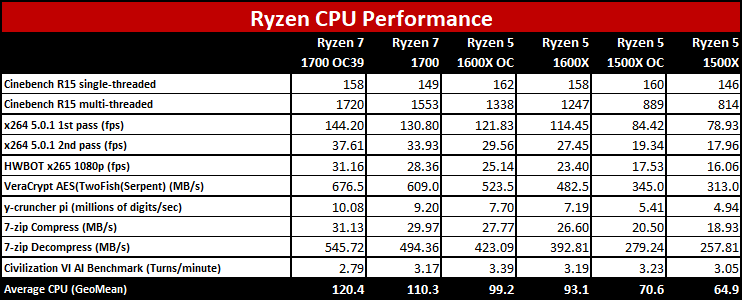
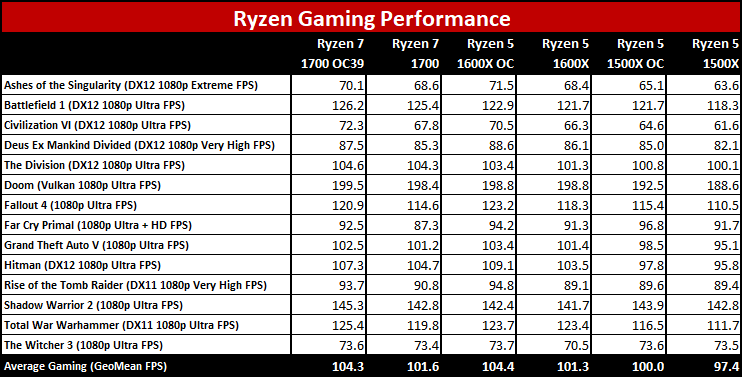
The 1600X doesn't get too much out of the overclocking, but the extra five percent vs. stock does help a bit. The 1500X improves more, but even there we're looking at mere eight percent increase in clockspeed over stock. If Ryzen 5 behaves like Ryzen 7, the 1600 and 1400 will be more compelling as overclocking chips, where the stock clocks are 3.3-3.4GHz range.
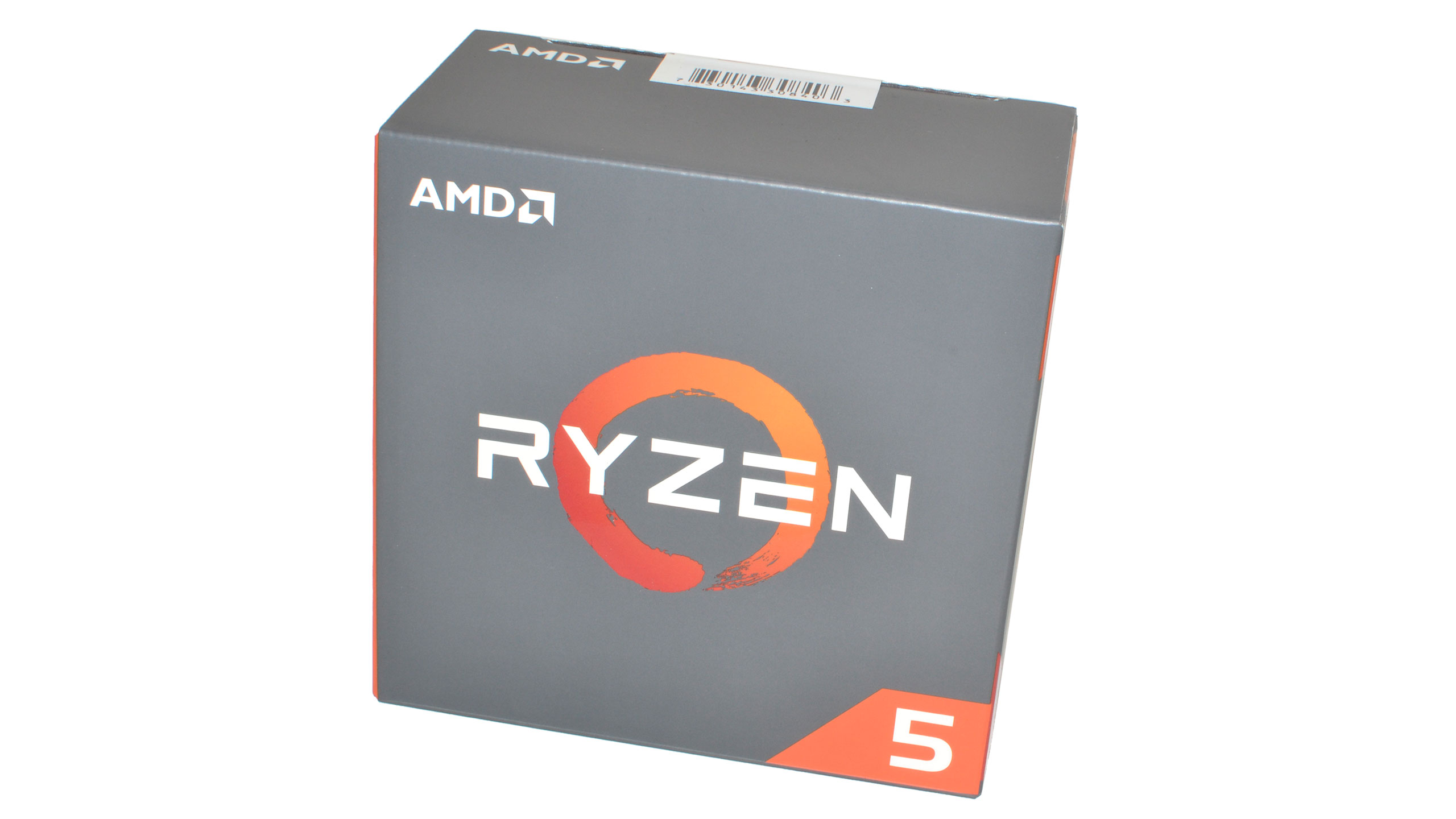
Ryzen 5: mainstream competition is a good thing
Ryzen 7 was impressive as a high performance CPU that brings 8-core computing down from the stratospheric Intel pricing to something you might actually buy. For non-gaming uses, it's extremely potent, so budding videographers or graphics artists should give those chips a look. But what if you're not quite that demanding, and you want to keep the CPU and motherboard price closer to $350 combined, rather than $350 on just the CPU? That's where Ryzen 5 and the B350 chipset come into play.
Ironically, compared to the X370 chipset, I had fewer issues with B350. I've spent more time banging my head against the Ryzen wall this past month than I care to admit. Ultimately, BIOS updates and game patches took care of the most grievous problems. There are still some minor concerns, like the integrated memory controller being prone to variations between CPUs, but that's primarily a concern for enthusiasts that overclock their RAM and CPU. The ASRock B350 Fatal1ty board in contrast worked (mostly) with several memory kits, and the only issue I encountered (in limited testing) was that the second x16 (Gen2, via the B350 chips) slot wouldn't work with graphics cards.
For modest users that just want a bit more CPU power than your typical Core i5 processor (for streaming, or maybe occasional video/photo editing), I really like the Ryzen 5 1600X. Most likely the Ryzen 5 1600 would be just as compelling, and a bit less expensive, but I haven't received one of those for testing yet. It costs the same as an i5-7600K, give or take, and you can even get the Wraith Spire heatsink with your processor for $250. That won't matter if you're planning on more exotic cooling, but AMD's heatsinks get the job done and you don't have to shell out an additional $30 or more for cooling.
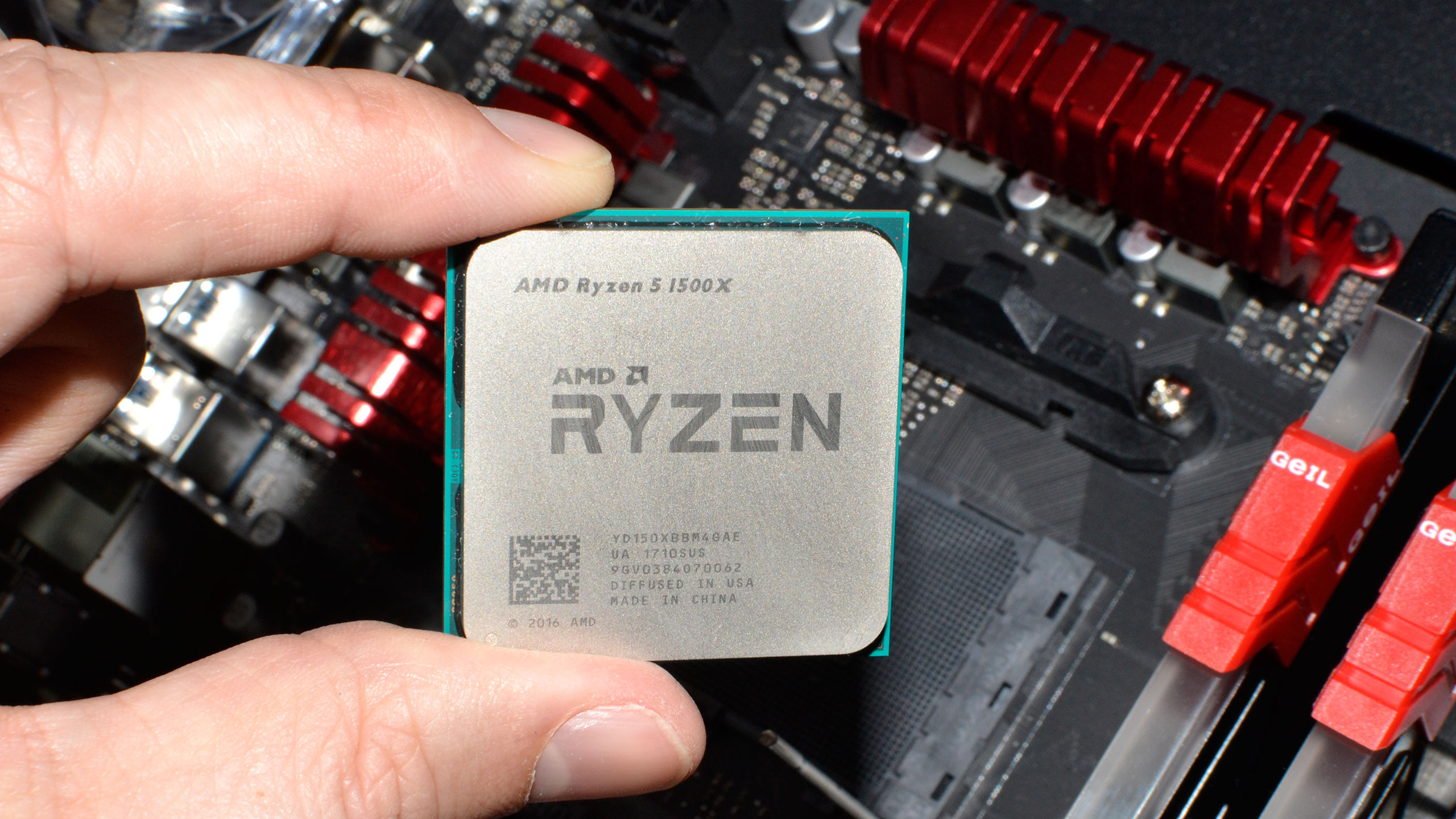
The Ryzen 5 1500X is a bit more difficult for me to recommend. It's priced lower, yes, and you still get more threads than Intel's $190 offerings… but the lower clocks and slightly less efficient architecture make the comparison more of a wash. Depending on your workload, the 1500X may be faster than an i5-7600K, but for gaming Intel wins. A slight boost to multi-threaded performance at the cost of gaming isn't as compelling as the significant CPU performance boost the 6-core parts offer.
There's also the fact that we've had quad-core plus SMT (Hyper-Threading) CPUs from Intel as far back as the 1st Gen Intel Core i7 (Bloomfield and later Lynnfield). That's nine years of 4C/8T processors, and I'm ready for us to move beyond those confines. But given the huge market share such chips already hold, it's not like games are going to ignore quad-core any time soon.
Ultimately, that's what's great about AMD's Ryzen processors. For the first time in nearly a decade, we have a non-Intel CPU option that doesn't require more power for less performance—in fact in some workloads it's less power while still providing more performance. More choice is always a good thing, and just like not everyone wants to drive a sports car, or an SUV, or a minivan, or a compact hybrid vehicle, not everyone wants to be stuck with Core i5 or Core i7 as the two best options. For pure gaming performance, I'd still point people to Intel, but if you're looking for something of a Jack-of-all-trades processor that won't break the bank, the new Ryzen 5 chips warrant serious consideration.
Jarred's love of computers dates back to the dark ages when his dad brought home a DOS 2.3 PC and he left his C-64 behind. He eventually built his first custom PC in 1990 with a 286 12MHz, only to discover it was already woefully outdated when Wing Commander was released a few months later. He holds a BS in Computer Science from Brigham Young University and has been working as a tech journalist since 2004, writing for AnandTech, Maximum PC, and PC Gamer. From the first S3 Virge '3D decelerators' to today's GPUs, Jarred keeps up with all the latest graphics trends and is the one to ask about game performance.


